Lateral Instability of Submarine Pipelines on Sloping Silt Seabeds: Experimental Investigation and an Improved Predictive Model
Abstract
1. Introduction
2. Experimental Modeling
2.1. Dimensional Analysis
2.2. Experimental Setup
2.3. Mechanical Loading
2.4. Material Properties and Test Conditions
2.5. Testing Procedure
- (1)
- Silt bed preparation: The sand-raining technique was used to form a saturated silt seabed at the target slope angle.
- (2)
- Initial embedment measurement: The pipe was positioned above the seabed within the water flume, and its submerged weight was calibrated with a load cell. After contact with the silt bed, laser sensors LDT-1 and LDT-2 were activated to record lateral displacement s and vertical initial embedment e0.
- (3)
- Mechanical loading: A servo motor applied an oblique load at 0.45 mm/s to simulate hydrodynamic forcing. Loading continued until lateral instability occurred.
- (4)
- Data acquisition: Force, displacement, and time-series data were synchronously recorded at 100 Hz using a tension load cell, laser sensors, and a high-speed camera.
3. Results and Discussion
3.1. Typical Features of Pipe-Silt Response
3.1.1. Cases with Minimal Initial Embedment
3.1.2. Cases with Large Initial Embedment
- Nonlinear growth stage (s/D < 0.1): FR increases rapidly, reaching a peak value FRu at point A (e.g., FRu = 0.42 kN/m in S-12). Notably, no soil heave ahead of the pipe or visible separation behind it is observed, indicating that passive earth pressure remains underdeveloped in silt. This suggests that interfacial adhesion and tensile resistance at the rear of the pipe may constitute the primary mechanisms governing FRu.
- Softening stage (0.1 ≤ s/D ≤ 0.477): At a critical displacement of s/D = 0.477, corresponding to the pipe axis detaching from its initial trench, FR decreases sharply by 28% to point B (e.g., FR = 0.30 kN/m in S-12). Concurrently, e/D reduces significantly from −0.35 to −0.16, and a pronounced soil berm develops ahead of the pipe.
- Residual strength stage (s/D > 0.477): With further displacement (up to s/D ≈ 1.3), FR declines to a residual value FRres at point C (e.g., FRres = 0.23 kN/m in S-12), while e/D approaches the mudline (Figure 7). The value of FRres closely aligns with those measured in cases featuring very small initial embedment (e.g., FRres = 0.21~0.23 kN/m in S-1, see Figure 5).
- (1)
- The absence of soil heave in front of the pipe indicates that passive earth pressure does not contribute significantly to FRu;
- (2)
- The near-zero pipe-soil contact force suggests that friction is negligible (see Section 3.2).
3.2. Breakout/Residual Resistance and Mobilization Displacement
- Low: 0.004 + 0.02|e0|/D;
- Best: 0.02 + 0.25|e0|/D;
- High: 0.1 + 0.7|e0|/D.
- Low: 0.6;
- Best: 1.5;
- High: 2.8.
3.3. Effects of Silt Seabed Slope
3.4. Effects of Submerged Pipe Weight
4. Improved Predictive Model
5. Conclusions
- (1)
- In contrast to sandy seabeds, the lateral pipe-soil interaction on silt exhibits more brittle characteristics. The difference between peak and residual soil resistance is closely related to the initial embedment ratio. When the initial embedment ratio is less than 0.05, this difference remains below 15%. Breakout soil resistance is primarily governed by interface friction and cohesion under shallow embedment conditions, while suction becomes the dominant mechanism at greater embedment depths.
- (2)
- For a fixed submerged pipe weight, the ultimate lateral drag force increases linearly with the slope angle, whereas the soil resistance decreases linearly. The difference between these two forces is attributed to the gravitational component Wssinα. The lateral–soil–resistance coefficient on silt follows the sequence: upslope > flat > downslope, a pattern that markedly contrasts with that observed on sandy seabeds. Moreover, the decay rate of this coefficient with increasing dimensionless submerged pipe weight is significantly more pronounced for silt than for sand.
- (3)
- A piecewise model is proposed to predict the ultimate lateral soil resistance, explicitly incorporating the influence of seabed slope. The model shows good agreement with experimental data and offers improved accuracy over existing DNV GL models, particularly for partially drained sloping silt seabeds.
6. Future Work
Author Contributions
Funding
Data Availability Statement
Conflicts of Interest
Notations
| A1 | Coefficient of the first-order term in Equation (1) |
| A2 | Coefficient of the second-order term in Equation (1) |
| c | Soil cohesion |
| c/γ′D | Dimensionless soil cohesion |
| Cc | Curvature coefficient of soil |
| CD | Drag force coefficient in Equation (7) |
| CL | Lift force coefficient in Equation (7) |
| Cu | Uniformity coefficient of soil |
| d50 | Mean size of soil grains |
| d50/D | Ratio of median particle size to pipe diameter |
| D | Outer diameter of pipe |
| Dr | Relative density of soil |
| e0 | Initial embedment (settlement) of pipe |
| e0/D | Ratio of initial embedment to pipe diameter |
| |e0|/D | Absolute value of e0/D |
| e/D | Embedment ratio during lateral instability of pipe |
| |e|/D | Absolute value of e/D |
| FC | Vertical pipe-soil contact force or support force of soil |
| FCu | Vertical contact force at which the ultimate lateral soil resistance is attained |
| FCu/γ′D2 | Dimensionless vertical contact force |
| FCres | Vertical contact force at which the residual lateral soil resistance is attained |
| FD | Drag force applied to the pipe by ocean currents |
| FDu | Ultimate (breakout) lateral drag force |
| FDu/γ′D2 | Dimensionless breakout drag force |
| FDres | Residual lateral drag force |
| FL | Lift force applied to the pipe by ocean currents |
| FR | Lateral soil resistance that prevents pipe instability. |
| FR0 | Initial lateral soil resistance against the pipe sliding downward along the seabed due to its submerged weight. |
| FRu | Ultimate (breakout) lateral soil resistance |
| FRu2 | Second peak lateral soil resistance, see Figure 8 |
| FRu/γ′D2 | Dimensionless ultimate lateral soil resistance |
| FRres | Residual lateral soil resistance |
| Dimensionless submerged weight of pipe | |
| g | Gravitational acceleration |
| h | Water depth in the flume |
| Ip | Plasticity index of soil |
| k | Surface roughness of pipe |
| k/D | Normalized pipe surface roughness |
| L | Length of the model pipe |
| p | Hydrostatic pressure |
| s | Lateral displacement of the pipe along the seabed surface |
| smob | Mobilization displacement required to achieve breakout soil resistance |
| sres | Mobilization displacement required to achieve residual soil resistance |
| t | Time |
| U | Current velocity |
| WS | Submerged weight of pipe |
| α | Seabed slope angle |
| Coefficient representing apparent friction coefficient at the pipe-silt interface in Equation (8) | |
| Coefficient representing cohesive resistance and soil berm effects in Equation (8) | |
| Dimensionless lateral-soil-resistance coefficient | |
| A constant in Equation (1) | |
| Effective (buoyant) unit weight of soil | |
| Inclination angle of the resultant hydrodynamic force relative to the seabed in Equation (7) | |
| ρw | Density of water |
| Internal friction angle of soil |
References
- Murawski, S.A.; Ainsworth, C.H.; Gilbert, S.; Hollander, D.J.; Paris, C.B.; Schlüter, M.; Wetzel, D.L. Scenarios and Responese to Future Deep Oil Spills-Fighting the Next War; Springer: Berlin/Heidelberg, Germany, 2020. [Google Scholar]
- Wang, L.X.; Pan, J.P.; Yang, L.L. Present conditions and prospect of global deepwater oil and gas exploration and development. Pet. Sci. Technol. Forum 2020, 39, 31–37. (In Chinese) [Google Scholar] [CrossRef]
- Jones, W.T. On-bottom pipeline stability in steady water currents. J. Pet. Technol. 1978, 30, 475–484. [Google Scholar] [CrossRef]
- Drumond, G.P.; Pasqualino, I.P.; Pinheiro, B.C.; Estefen, S.F. Pipelines, risers and umbilicals failures: A literature review. Ocean Eng. 2018, 148, 412–425. [Google Scholar] [CrossRef]
- Palmer, A.C.; King, R.A. Subsea Pipeline Engineering, 2nd ed.; PennWell Corporation: Tulsa, OK, USA, 2008. [Google Scholar]
- Det Norske Veritas (DNV). DNV-RP-F109: On-Bottom Stability Design of Submarine Pipelines; DNV: Oslo, Norway, 2010. [Google Scholar]
- Det Norske Veritas, Germanischer Lloyd (DNV GL). DNVGL-RP-F114: Pipe-Soil Interaction for Submarine Pipelines; DNV GL: Oslo, Norway, 2021. [Google Scholar]
- Det Norske Veritas, Germanischer Lloyd (DNV GL). DNVGL-RP-F110: Global Buckling of Submarine Pipelines Due to High Temperature/High Pressure; DNV GL: Oslo, Norway, 2018. [Google Scholar]
- Dingle, H.R.C.; White, D.J.; Gaudin, C. Mechanisms of pipe embedment and lateral breakout on soft clay. Can. Geotech. J. 2008, 45, 636–652. [Google Scholar] [CrossRef]
- White, D.J.; Dingle, H.R.C. The mechanism of steady friction between seabed pipelines and clay soils. Géotechnique 2011, 61, 1035–1041. [Google Scholar] [CrossRef]
- Youssef, B.S.; Tian, Y.; Cassidy, M.J. Centrifuge modelling of an on-bottom pipeline under equivalent wave and current loading. Appl. Ocean Res. 2013, 40, 14–25. [Google Scholar] [CrossRef]
- Lyons, C.G. Soil resistance to lateral sliding of marine pipelines. In Proceedings of the Fifth Annual Offshore Technology Conference, Houston, TX, USA, 28 April–1 May 1973; Volume OTC1876, pp. 479–484. [Google Scholar]
- Wagner, D.A.; Murff, J.D.; Brennodden, H.; Sveggen, O. Pipe-soil interaction model. J. Waterw. Port Coast. Ocean. Eng. 1989, 115, 205–220. [Google Scholar] [CrossRef]
- Verley, R.L.P.; Sotberg, T. A soil resistance model for pipelines placed on sandy soils. J. Offshore Mech. Arct. Eng. 1994, 116, 145–153. [Google Scholar] [CrossRef]
- Fredsøe, J. Pipeline–seabed interaction. J. Water. Port Coast. 2016, 142, 03116002. [Google Scholar] [CrossRef]
- Cai, J.; Grognec, P.L. Lateral buckling of submarine pipelines under high temperature and high pressure—A literature review. Ocean Eng. 2022, 244, 110254. [Google Scholar] [CrossRef]
- Wang, N.; Qi, W.G.; Gao, F.P. Predicting the instability trajectory of an obliquely loaded pipeline on a clayey seabed. J. Mar. Sci. Eng. 2022, 10, 299. [Google Scholar] [CrossRef]
- Wang, L.; Liu, R. The effect of a berm on the lateral resistance of a shallow pipeline buried in sand. Ocean Eng. 2016, 121, 13–23. [Google Scholar] [CrossRef]
- Liu, R.; Guan, Y.Z.; Li, C.F.; Sun, X.; Liu, Y.N.; Yu, Z. Study on the lateral breakout resistance of submarine pipelines in the sand wave area. Ocean Eng. 2025, 329, 121126. [Google Scholar] [CrossRef]
- Gao, F.P.; Gu, X.Y.; Jeng, D.S.; Teo, H.T. An experimental study for wave-induced instability of pipelines: The breakout of pipelines. Appl. Ocean Res. 2002, 24, 83–90. [Google Scholar] [CrossRef]
- Gao, F.P.; Yang, B.; Yan, S.M.; Wu, Y.X. Occurrence of spanning of a submarine pipeline with initial embedment. In Proceedings of the 6th International Offshore and Polar Engineering Conference, Lisbon, Portugal, 1–6 July 2007. [Google Scholar]
- Gao, F.P. On-Bottom Stability of Submarine Pipelines. In Encyclopedia of Ocean Engineering; Springer: Berlin/Heidelberg, Germany, 2020. [Google Scholar]
- Wang, F.Y.; Zhang, J.S.; Guo, Y.K.; Chen, H.; Zhang, Y.C.; Wang, G.H.; Zhang, Q.B. On the scour characteristics of submarine flexible cable in three-dimensional flow. Ocean Eng. 2025, 322, 120458. [Google Scholar] [CrossRef]
- Zhao, M. A comprehensive review of the research on local scour below subsea pipelines under steady currents and waves. Ocean Eng. 2025, 318, 120114. [Google Scholar] [CrossRef]
- Gao, F.P.; Luo, C.C. Flow-pipe-seepage coupling analysis of spanning initiation of a partially-embedded pipeline. J. Hydrodyn. 2010, 22, 478–487. [Google Scholar] [CrossRef]
- Shi, Y.M.; Gao, F.P. Lateral instability and tunnel erosion of a submarine pipeline: Competition mechanism. Bull. Eng. Geol. Environ. 2018, 77, 1069–1080. [Google Scholar] [CrossRef]
- Shi, Y.M.; Gao, F.P.; Wang, N.; Yin, Z.Y. Coupled flow-seepage-elastoplastic modeling for competition mechanism between lateral instability and tunnel erosion of a submarine pipeline. J. Mar. Sci. Eng. 2021, 9, 825. [Google Scholar] [CrossRef]
- Zang, Z.P.; Chen, Y.F.; Zhang, J.F.; Tian, Y.H.; Esteban, M.D. Experimental study on local scour and onset of VIV of a pipeline on a silty seabed under steady currents. Appl. Ocean Res. 2021, 109, 102560. [Google Scholar] [CrossRef]
- Coleman, J.M.; Bouma, A.H.; Prior, D.B.; Roberts, H.H. Near-surface geology of the Gulf of Mexico continental slope. In Proceedings of the 21st Annual Offshore Technology Conference, Houston, TX, USA, 1–4 May 1989. [Google Scholar]
- Zhou, Q.J.; Dong, Y.K.; Liu, L.J.; Li, X.S. Sedimentation characteristics of surficial sediments in baiyun canyon area, northern south China sea. Cont. Shelf Res. 2024, 282, 105342. [Google Scholar] [CrossRef]
- Shi, Y.M.; Wang, N.; Gao, F.P.; Qi, W.G.; Wang, J.Q. Anti-sliding capacity for submarine pipeline walking on a sloping sandy seabed. Ocean Eng. 2019, 178, 20–30. [Google Scholar] [CrossRef]
- Ye, Y.C.; Lai, X.H.; Pan, G.F.; Li, Q.T.; Zhuang, Z.Y.; Liu, D.J.; Chen, X.L.; Wei, Y.J.; Chen, J.R.; Hu, T.J.; et al. Marine Geo-Hazards in China; China Ocean Press: Beijing, China, 2017. [Google Scholar]
- Rafiei, A.; Rahman, M.S.; Gabr, M.A. Coupled analysis for response and instability of sloping seabed under wave action. Appl. Ocean Res. 2019, 88, 99–110. [Google Scholar] [CrossRef]
- Feng, A.; Magee, A.R.; Price, W.G. Two dimensional wave-current-structure interaction with flat or sloping seabed environment in a linearized framework. Ocean Eng. 2019, 173, 732–747. [Google Scholar] [CrossRef]
- Xu, L.Y.; Zhang, J.; Wang, L.; Chen, W.Y.; Cai, F.; Xue, Y.Y.; Chen, G.X. Wave-induced liquefaction analysis of mildly sloping sandy seabed. Soil Dyn. Earthq. Eng. 2024, 185, 108873. [Google Scholar] [CrossRef]
- Bransby, M.F.; Barlow, D.T.; Brown, M.J.; Davidson, J.; Brankin, S.; Robinson, S. The performance of pipeline ploughs traversing seabed slopes. Ocean Eng. 2018, 148, 125–135. [Google Scholar] [CrossRef]
- Gao, F.P.; Han, X.T.; Cao, J.; Sha, Y.; Cui, J.S. Submarine pipeline lateral instability on a sloping sandy seabed. Ocean Eng. 2012, 50, 44–52. [Google Scholar] [CrossRef]
- Peng, Y.; Qu, L. Micromechanical analysis of lateral pipe–soil interaction instability on sloping sandy seabeds. J. Mar. Sci. Eng. 2024, 12, 225. [Google Scholar] [CrossRef]
- Gao, F.P.; Wang, N.; Li, J.H.; Han, X.T. Pipe-soil interaction model for current-induced pipeline instability on a sloping sandy seabed. Can. Geotech. J. 2016, 53, 1822–1830. [Google Scholar] [CrossRef]
- Shi, Y.M.; Gao, F.P. Analytical model for predicting lateral instability of a submarine pipeline on the soft clayey seabed. Period. Ocean Univ. China 2017, 47, 141–147. (In Chinese) [Google Scholar]
- Craig, R.F. Craig’s Soil Mechanics, 7th ed.; Taylor & Francis Group: London, UK, 2004. [Google Scholar]
- Xu, K.; Gao, F.P.; Qi, W.G. Sliding-rolling mechanism for lateral stability of the pipeline on a silty seabed. In Proceedings of the 13th Pacific-Asia Offshore Mechanics Symposium, Jeju, Republic of Korea, 14–17 October 2018. [Google Scholar]
- Taylor, R.N. Geotechnical Centrifuge Technology; Taylor & Francis Group: London, UK, 1995. [Google Scholar]
- Gao, F.P.; Yan, S.M.; Yang, B.; Luo, C.C. Steady flow-induced instability of a partially embedded pipeline: Pipe-soil interaction mechanism. Ocean Eng. 2011, 38, 934–942. [Google Scholar] [CrossRef]
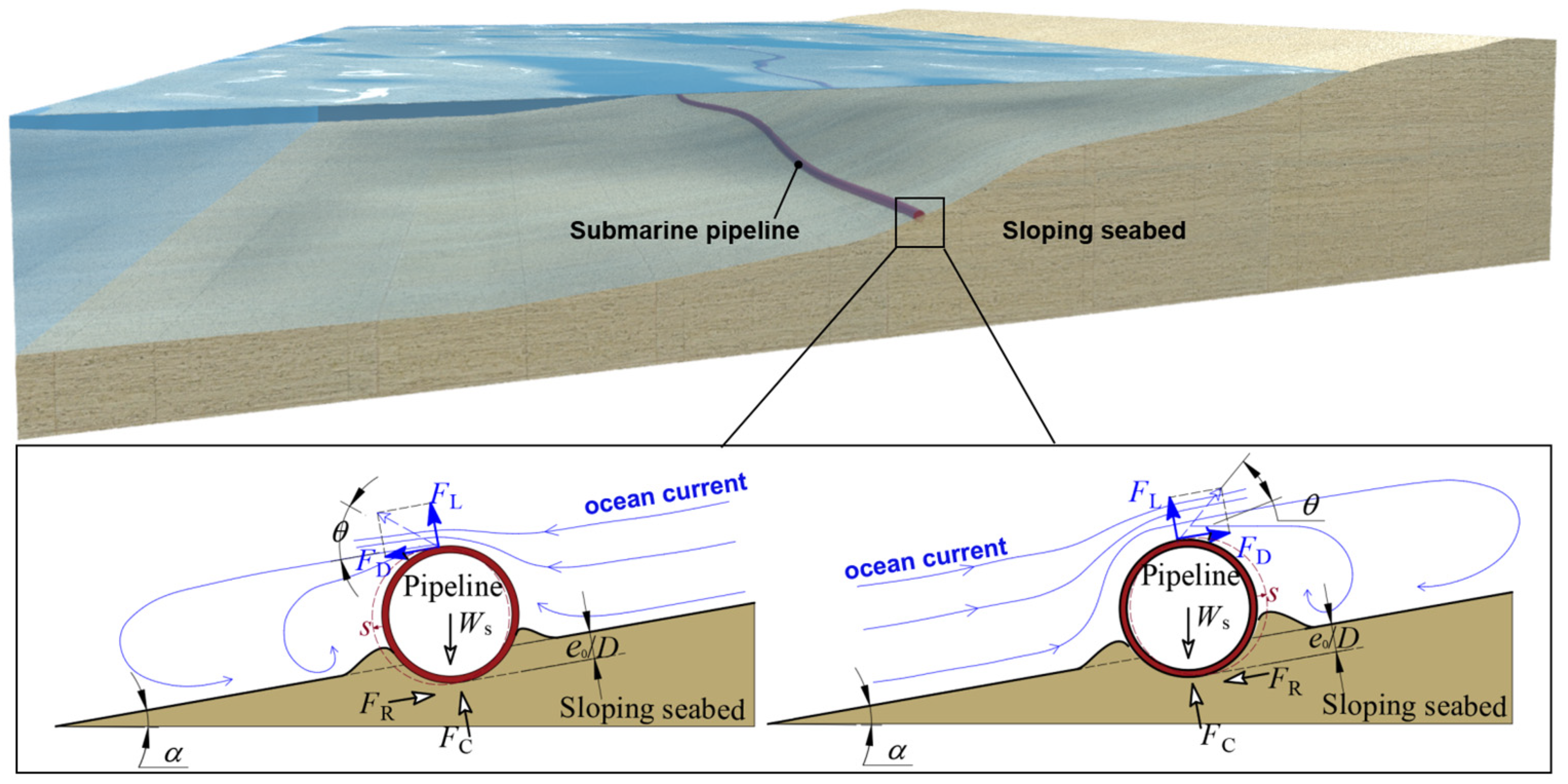


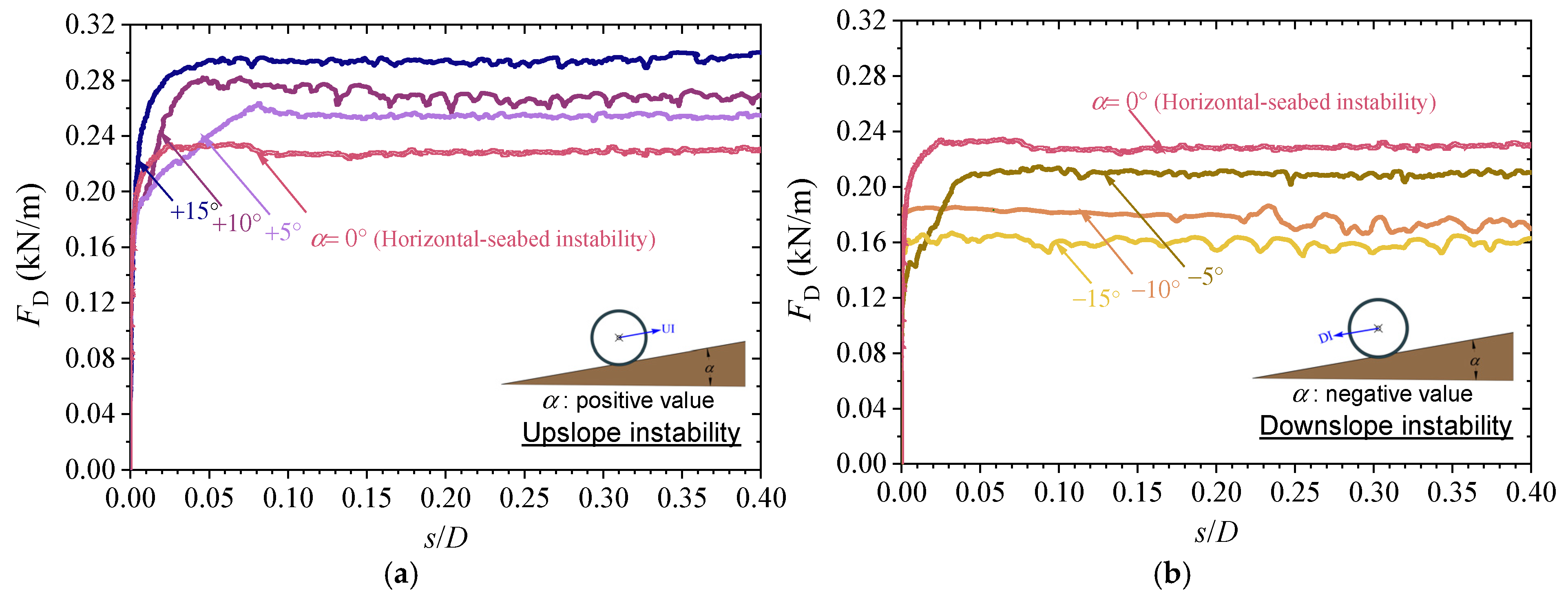

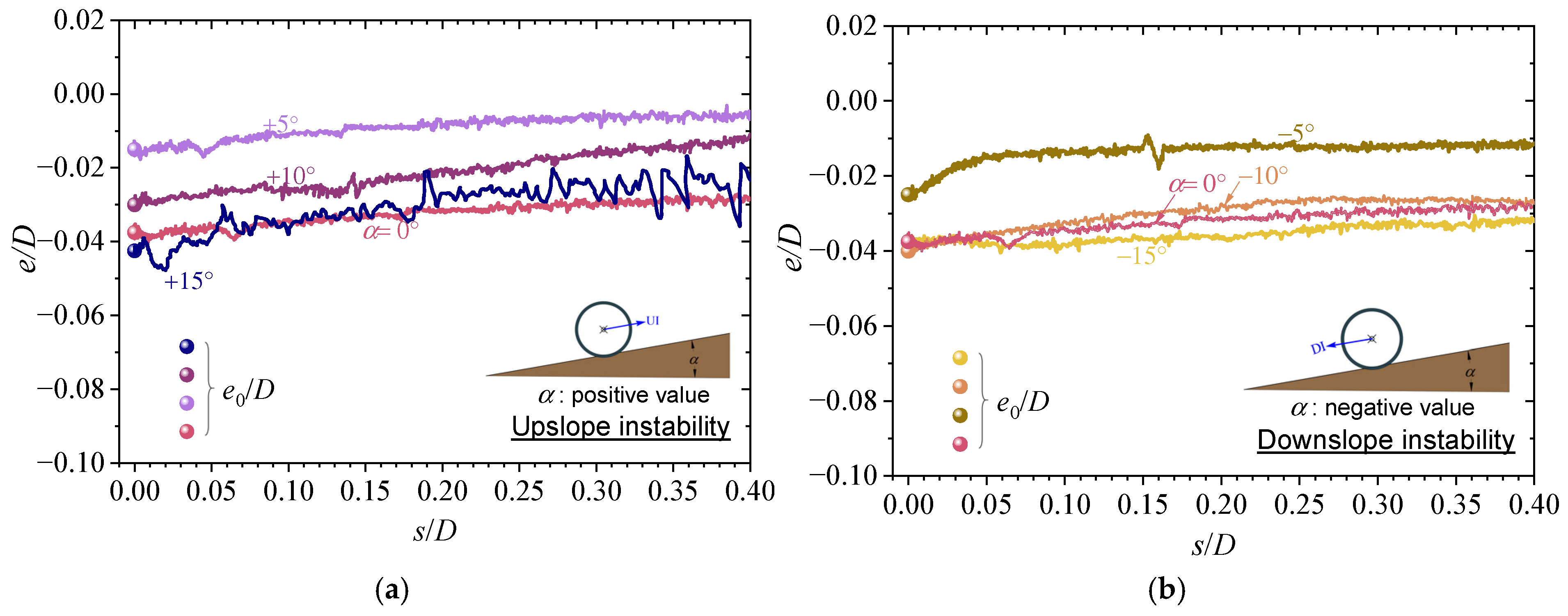



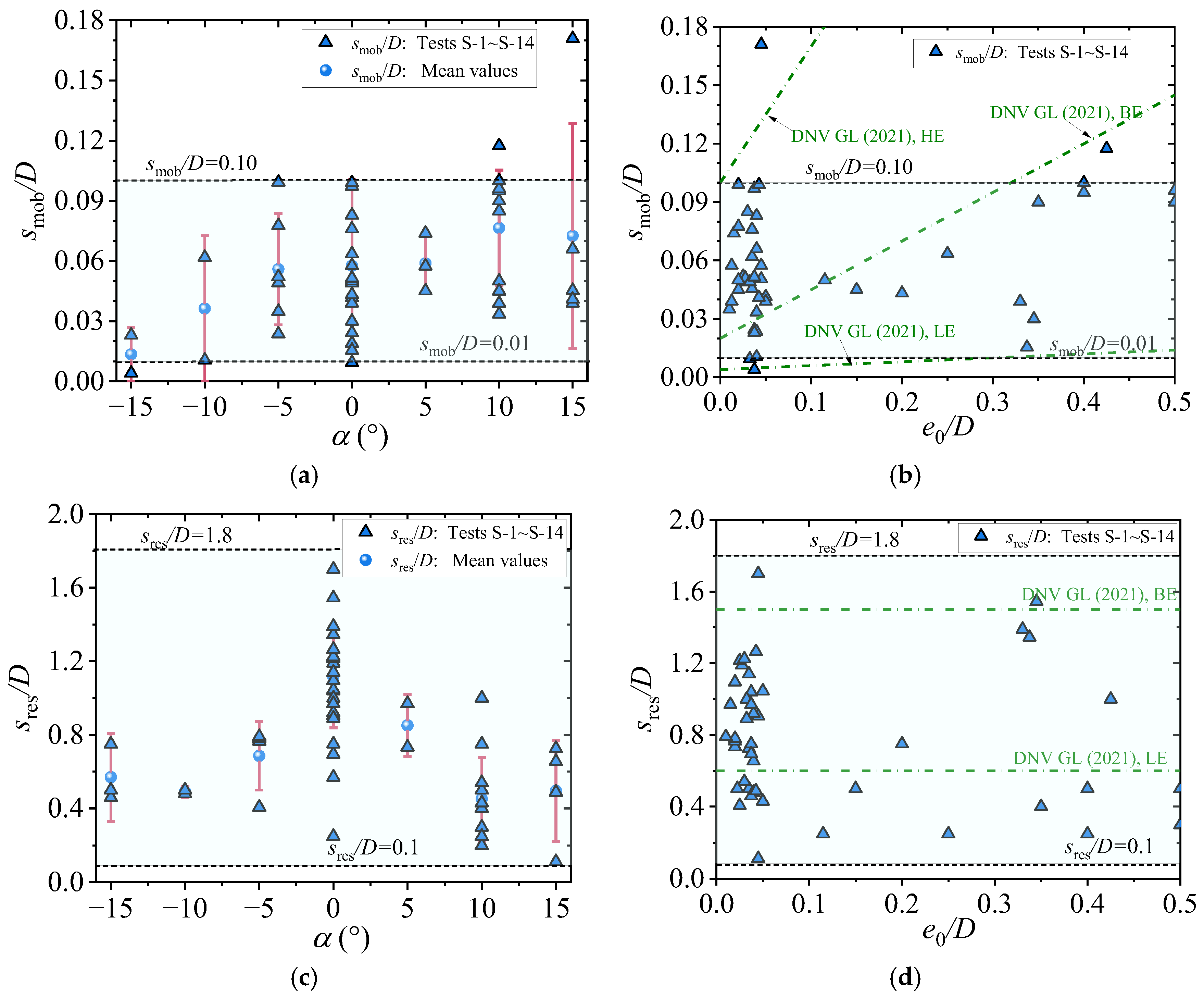
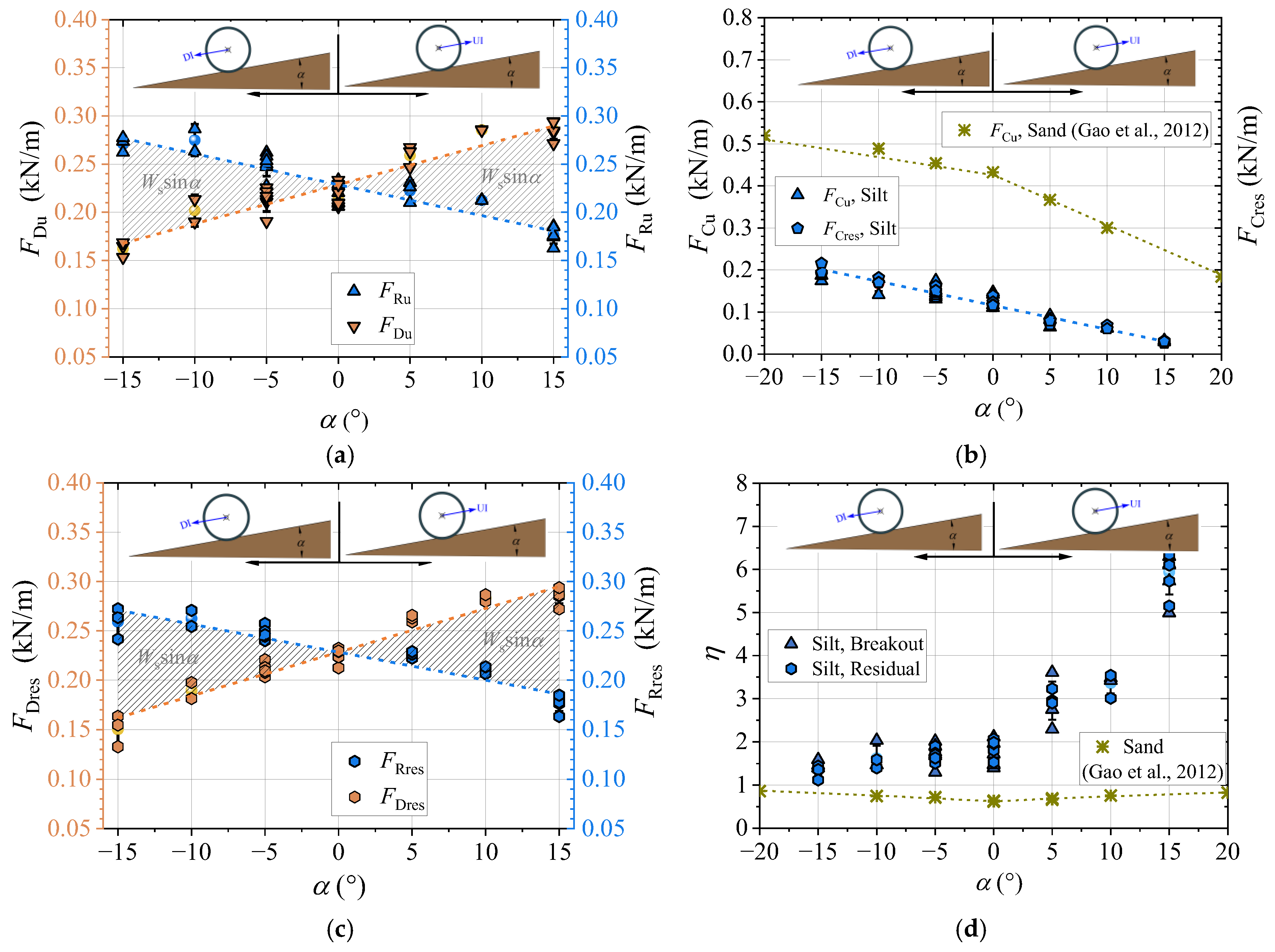
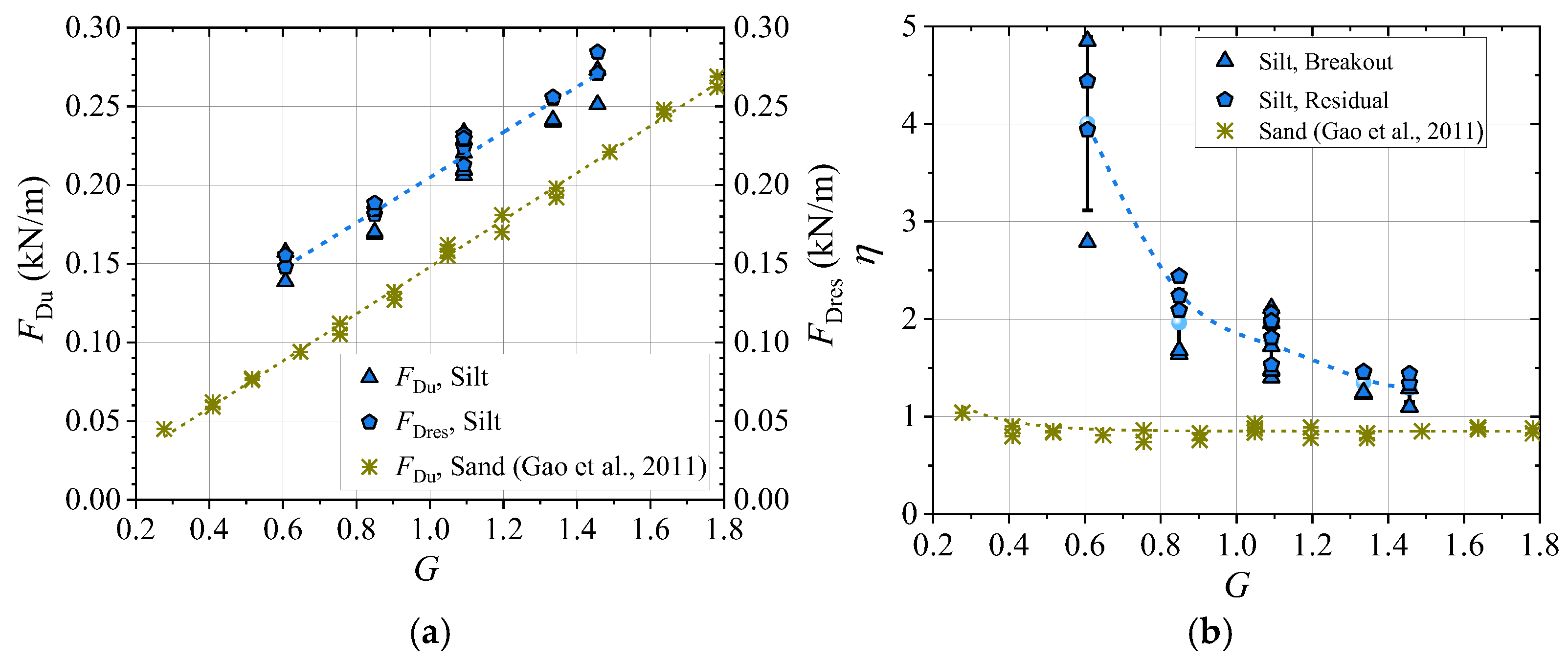


| Test No. | α (°) | Repeat Tests | Ws (N/m) | e0 (cm) | Breakout | Residual | |||||||
|---|---|---|---|---|---|---|---|---|---|---|---|---|---|
| FDu (N/m) | FRu (N/m) | FCu (N/m) | η | smob (cm) | FDres (N/m) | FRres (N/m) | FCres (N/m) | η | |||||
| S-1 | 0 | 1 | 420.7 | −0.75 | 220.4 | 220.4 | 128.1 | 1.72 | 1.94 | 229.0 | 229.0 | 116.8 | 1.96 |
| S-1 | 0 | 2 | 420.7 | −0.75 | 233.5 | 233.5 | 110.7 | 2.11 | 0.49 | 232.2 | 232.2 | 112.7 | 2.06 |
| S-1 | 0 | 3 | 420.7 | −0.90 | 206.1 | 206.1 | 147.2 | 1.40 | 1.01 | 212.6 | 212.6 | 139.0 | 1.53 |
| S-1 | 0 | 4 | 420.7 | −0.80 | 210.0 | 210.0 | 141.9 | 1.48 | 1.66 | 223.7 | 223.7 | 123.6 | 1.81 |
| S-1 | 0 | 5 | 420.7 | −0.65 | 210.0 | 210.0 | 141.9 | 1.48 | 0.19 | 229.0 | 229.0 | 116.8 | 1.96 |
| S-1 | 0 | 6 | 420.7 | −0.90 | 209.3 | 209.3 | 142.4 | 1.47 | 1.15 | 229.0 | 229.0 | 116.8 | 1.96 |
| S-1 | 0 | 7 | 420.7 | −1.00 | 229.0 | 229.0 | 116.8 | 1.96 | 0.83 | 229.6 | 229.6 | 116.0 | 1.98 |
| S-2 | 5 | 1 | 420.7 | −0.40 | 246.6 | 210.0 | 91.7 | 2.29 | 0.90 | 259.0 | 222.4 | 75.4 | 2.95 |
| S-2 | 5 | 2 | 420.7 | −0.25 | 267.5 | 230.9 | 64.0 | 3.61 | 1.15 | 263.0 | 226.3 | 70.1 | 3.23 |
| S-2 | 5 | 3 | 420.7 | −0.30 | 263.0 | 226.3 | 82.3 | 2.75 | 1.48 | 265.7 | 229.0 | 79.0 | 2.90 |
| S-3 | −5 | 1 | 420.7 | −0.80 | 225.5 | 262.2 | 130.4 | 2.01 | 0.47 | 220.8 | 257.5 | 136.2 | 1.89 |
| S-3 | −5 | 2 | 420.7 | −0.60 | 210.6 | 247.3 | 139.7 | 1.77 | 0.98 | 208.7 | 245.3 | 141.8 | 1.73 |
| S-3 | −5 | 3 | 420.7 | −0.40 | 221.5 | 258.2 | 135.9 | 1.90 | 1.98 | 203.4 | 240.1 | 159.0 | 1.51 |
| S-3 | −5 | 4 | 420.7 | −0.50 | 213.5 | 250.1 | 145.4 | 1.72 | 1.04 | 212.8 | 249.5 | 146.8 | 1.70 |
| S-3 | −5 | 5 | 420.7 | −0.40 | 216.8 | 253.5 | 150.9 | 1.68 | 1.55 | 207.9 | 244.6 | 162.0 | 1.51 |
| S-3 | −5 | 6 | 420.7 | −0.20 | 190.7 | 227.4 | 174.9 | 1.30 | 0.70 | 209.5 | 246.1 | 151.0 | 1.63 |
| S-4 | 10 | 1 | 420.7 | −0.60 | 285.9 | 212.9 | 61.2 | 3.48 | 1.70 | 279.8 | 206.7 | 68.7 | 3.01 |
| S-4 | 10 | 2 | 420.7 | −1.00 | 285.2 | 212.2 | 62.0 | 3.42 | 0.78 | 286.6 | 213.6 | 60.3 | 3.54 |
| S-5 | −10 | 1 | 420.7 | −0.80 | 213.5 | 286.5 | 141.1 | 2.03 | 0.21 | 181.4 | 254.4 | 181.7 | 1.40 |
| S-5 | −10 | 2 | 420.7 | −0.70 | 190.2 | 263.2 | 179.0 | 1.47 | 1.24 | 197.7 | 270.7 | 170.3 | 1.59 |
| S-6 | 15 | 1 | 420.7 | −0.90 | 294.4 | 185.6 | 29.5 | 6.30 | 3.42 | 292.4 | 183.6 | 32.0 | 5.73 |
| S-6 | 15 | 2 | 420.7 | −0.70 | 283.2 | 174.4 | 30.4 | 5.73 | 0.91 | 285.2 | 176.3 | 27.8 | 6.34 |
| S-6 | 15 | 3 | 420.7 | −0.25 | 271.5 | 162.7 | 32.6 | 4.99 | 0.78 | 272.2 | 163.3 | 31.7 | 5.15 |
| S-6 | 15 | 4 | 420.7 | −0.80 | 284.6 | 175.7 | 28.7 | 6.12 | 1.32 | 286.5 | 177.6 | 26.1 | 6.81 |
| S-6 | 15 | 5 | 420.7 | −0.85 | 293.8 | 184.9 | 30.3 | 6.10 | 0.82 | 293.8 | 184.9 | 30.3 | 6.10 |
| S-7 | −15 | 1 | 420.7 | −0.75 | 164.8 | 273.7 | 187.5 | 1.46 | 0.08 | 163.5 | 272.4 | 189.2 | 1.44 |
| S-7 | −15 | 2 | 420.7 | −0.45 | 168.7 | 277.5 | 174.5 | 1.59 | -- | 154.6 | 263.5 | 193.8 | 1.36 |
| S-7 | −15 | 3 | 420.7 | −0.75 | 153.4 | 262.2 | 187.3 | 1.40 | 0.46 | 132.8 | 241.7 | 215.8 | 1.12 |
| S-8 | 0 | 1 | 233.7 | −0.55 | 138.7 | 138.7 | 49.7 | 2.79 | 1.02 | 147.8 | 147.8 | 37.5 | 3.94 |
| S-8 | 0 | 2 | 233.7 | −0.65 | 157.3 | 157.3 | 32.4 | 4.85 | 0.98 | 155.3 | 155.3 | 35.0 | 4.44 |
| S-9 | 0 | 1 | 327.2 | -- | 170.1 | 170.1 | 101.3 | 1.68 | 0.38 | 181.2 | 181.2 | 86.7 | 2.09 |
| S-9 | 0 | 2 | 327.2 | −0.50 | 168.8 | 168.8 | 102.9 | 1.64 | -- | 184.5 | 184.5 | 82.4 | 2.24 |
| S-9 | 0 | 3 | 327.2 | −0.40 | 170.1 | 170.1 | 101.3 | 1.68 | 1.00 | 188.4 | 188.4 | 77.2 | 2.44 |
| S-10 | 0 | 1 | 514.1 | −0.75 | 240.1 | 240.1 | 195.2 | 1.23 | 1.03 | 255.1 | 255.1 | 175.9 | 1.45 |
| S-10 | 0 | 2 | 514.1 | −0.60 | 241.4 | 241.4 | 193.1 | 1.25 | 3.89 | 255.8 | 255.8 | 175.2 | 1.46 |
| S-11 | 0 | 1 | 560.9 | −0.70 | 251.2 | 251.2 | 228.4 | 1.10 | 1.52 | 270.8 | 270.8 | 202.9 | 1.34 |
| S-11 | 0 | 2 | 560.9 | −0.85 | 273.0 | 273.0 | 211.6 | 1.29 | 1.98 | 284.4 | 284.4 | 197.5 | 1.44 |
| S-12 | 0 | 1 | 420.7 | −6.75 | 377.4 | 377.4 | 0 | -- | 0.31 | 231.6 | 231.6 | 113.4 | 2.04 |
| S-12 | 0 | 2 | 420.7 | −6.60 | 403.0 | 403.0 | 0 | -- | 0.78 | 230.1 | 230.1 | 115.3 | 2.00 |
| S-12 | 0 | 3 | 420.7 | −6.90 | 421.6 | 421.6 | 0 | -- | 0.60 | 227.5 | 227.5 | 129.4 | 1.76 |
| S-12 | 0 | 4 | 420.7 | −6.80 | 450.0 | 450.0 | 0 | -- | 0.30 | 240.0 | 240.0 | 114.5 | 2.09 |
| S-12 | 0 | 5 | 420.7 | −4.00 | 328.5 | 328.5 | 0 | -- | 0.60 | 233.2 | 233.2 | 110.0 | 2.12 |
| S-12 | 0 | 6 | 420.7 | −4.00 | 395.6 | 395.6 | 0 | -- | 0.78 | 280.9 | 280.9 | 115.2 | 2.43 |
| S-13 | 10 | 1 | 420.7 | −7.00 | 455.9 | 382.9 | 0 | -- | 1.80 | 353.9 | 280.9 | 0 | -- |
| S-13 | 10 | 2 | 420.7 | −10.00 | 1053.8 | 1313.7 | 0 | -- | 1.80 | 371.6 | 298.5 | 0 | -- |
| S-13 | 10 | 3 | 420.7 | −8.00 | 655.5 | 582.4 | 0 | -- | 1.90 | 423.2 | 350.2 | 0 | -- |
| S-13 | 10 | 4 | 420.7 | −2.30 | 397.1 | 324.0 | 0 | -- | 1.00 | 307.5 | 234.4 | 5.8 | 40.40 |
| S-13 | 10 | 5 | 420.7 | −0.80 | 340.2 | 267.1 | 0 | -- | 0.67 | 333.0 | 256.0 | 0 | -- |
| S-13 | 10 | 6 | 420.7 | −3.00 | 377.7 | 304.6 | 0 | -- | 0.90 | 217.8 | 144.8 | 115.2 | 1.26 |
| S-14 | 10 | 1 | 607.6 | −8.50 | 597.6 | 492.1 | 0 | -- | 2.35 | 468.4 | 362.9 | 0 | -- |
| S-14 | 10 | 2 | 607.6 | −10.00 | 962.8 | 857.3 | 0 | -- | 1.92 | 512.4 | 406.9 | 0 | -- |
| S-14 | 10 | 3 | 607.6 | −8.00 | 570.5 | 465.0 | 0 | -- | 2.00 | 438.4 | 332.9 | 16.6 | 20.05 |
| Median Diameter | Internal Friction Angle | Cohesion | Plasticity Index | Relative Density | Buoyant Unit Weight |
|---|---|---|---|---|---|
| d50 (mm) | φ (°) | c (kPa) | Ip (%) | Dr | γ′ (kN/m3) |
| 0.047 | 27.4 | 6.0 | 7.6 | 0.59 | 9.63 |
Disclaimer/Publisher’s Note: The statements, opinions and data contained in all publications are solely those of the individual author(s) and contributor(s) and not of MDPI and/or the editor(s). MDPI and/or the editor(s) disclaim responsibility for any injury to people or property resulting from any ideas, methods, instructions or products referred to in the content. |
© 2025 by the authors. Licensee MDPI, Basel, Switzerland. This article is an open access article distributed under the terms and conditions of the Creative Commons Attribution (CC BY) license (https://creativecommons.org/licenses/by/4.0/).
Share and Cite
Zhao, D.; He, Y.; Shi, Y.; Wang, N.; Liu, J.; Zhang, Y. Lateral Instability of Submarine Pipelines on Sloping Silt Seabeds: Experimental Investigation and an Improved Predictive Model. J. Mar. Sci. Eng. 2025, 13, 2147. https://doi.org/10.3390/jmse13112147
Zhao D, He Y, Shi Y, Wang N, Liu J, Zhang Y. Lateral Instability of Submarine Pipelines on Sloping Silt Seabeds: Experimental Investigation and an Improved Predictive Model. Journal of Marine Science and Engineering. 2025; 13(11):2147. https://doi.org/10.3390/jmse13112147
Chicago/Turabian StyleZhao, Dang, Yang He, Yumin Shi, Ning Wang, Jun Liu, and Ying Zhang. 2025. "Lateral Instability of Submarine Pipelines on Sloping Silt Seabeds: Experimental Investigation and an Improved Predictive Model" Journal of Marine Science and Engineering 13, no. 11: 2147. https://doi.org/10.3390/jmse13112147
APA StyleZhao, D., He, Y., Shi, Y., Wang, N., Liu, J., & Zhang, Y. (2025). Lateral Instability of Submarine Pipelines on Sloping Silt Seabeds: Experimental Investigation and an Improved Predictive Model. Journal of Marine Science and Engineering, 13(11), 2147. https://doi.org/10.3390/jmse13112147







